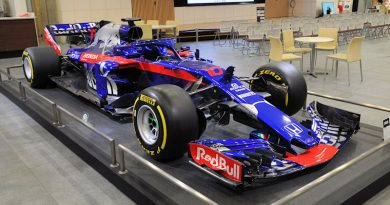The Story Behind Grand Prix’s Biggest Starting Grid
#130 – ‘Bernhard Nacke’ (Karl-Günther Bechem) — Holbein HH48 – BMW
Grid: 30th / Race: Retired (5 laps / Ignition)
|
|
|
| Born: | 21st December 1921 Hagen, Germany |
| Died: | 3rd May 2001 Hagen, Germany |
| Appearances: | 2 (1952 & 1953 German GP) |
Biography
Nürburgring, 20th August 1950 and the first international German GP after the war. A crowd of hundreds of thousands of spectators, excited for the main event to see their new post-war silver arrows to compete against the international elite. In the supporting sports car race they see an unknown newcomer with an old BMW 328 production model finishing in second place. Karl-Günther Bechem was born in 1921 into an industrialist family, his father owning a steel factory. However, unlike other descendants from wealthy families he would not give any support to his son for such useless activities like motor racing, so Bechem had to make full use of his ‘organisational’ talent to get his hands on an old BMW 328 with standard-production 80 hp engine. Inspired by his immediate success at the Nürburgring, for 1951 Bechem took over the remains of the AFM Formula 2 car in which Karl Gommann had had his fatal accident at the Grenzlandring and had it rebuilt in two-seater configuration as a Barchetta-style sports car. With this he campaigned the 1951 season, but had to wait until the race at Nürnberg in September before he could take his first victory laurels.
With all the publicity, he could no longer hide his activities from his father, who did not want his family name to be connected with motor racing. So, being creative as ever, Bechem had his racing license registered under the pseudonym ‘Bernhard Nacke’, thereby confusing some of the motor sport databases up to our time. Alongside the AFM sports car he also bought the Holbein HH48 monoposto, which had been one of Germany’s first Formula 2 cars in 1948. This now presented him the opportunity to start in more than one race during race weekends, which – even if he could not expect too much performance from the four-year-old single seater – at least meant some good additional starting money to his racing funds.
It was in this ancient and outclassed Holbein that Bechem made his Grand Prix debut, entered under his pseudonym ‘Bernhard Nacke’. The car proved slow and unreliable both in the Grand Prix and in future races and he sold it to Sweden in 1953.
Having sold the uncompetitive mosoposto, he ordered an additional replacement body for his AFM. So, with only a couple of screws to unfix he could easily exchange the car’s identity to collect double starting money from the race organisers.
After succeeding his father in the management of the factory, Bechem no longer had to race under a false name and was even invited to test drive for Mercedes. While Neubauer did not offer him a contract, Carl Borgward, whose company was supplied steel by Bechem’s factory, offered him a deal to drive for his sports car team. Bechem repaid Borgward by winning the 1.5 litre class in the 1953 1000 km race at the Nürburgring (with Brudes and Helfrich as co-drivers) and a win in the 1954 Eifelrennen. However, at the end of the season he had a heavy crash in the Carrera Panamericana, which left him with a broken thigh and with all the publicity around this incident he decided to step back from top level motorsport, concentrating on running the family’s factory instead.
Bechem would not have been Bechem if he had rejected the offer of Eberhard Mahle (of the well-known ‘Mahle’ piston manufacturer) to race his DKW Formula Junior in 1959 and so he had to revive the identity of ‘Bernhard Nacke’ one last time before he finally promised his wife he would quit racing.






